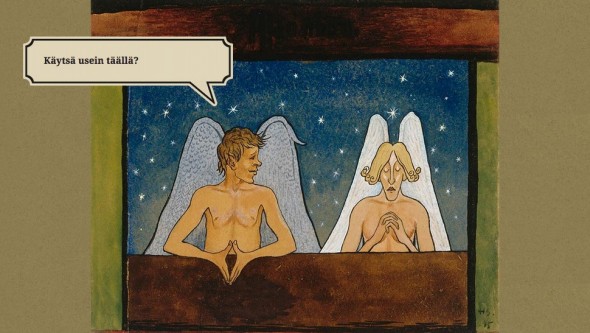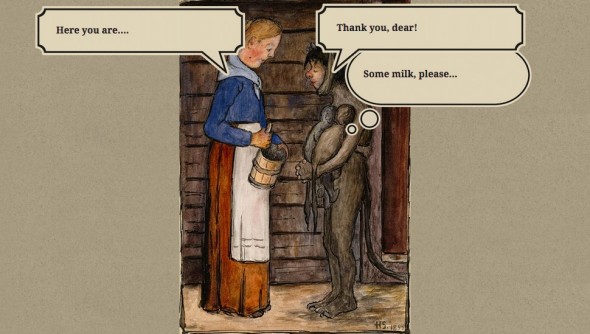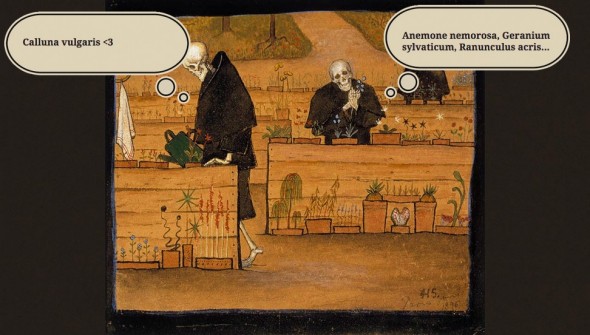Archive for June, 2015
Time to go
29 June 2015 | Greetings
[kml_flashembed publishmethod=”static” fversion=”8.0.0″ movie=”https://booksfromfinland.fi/wp-content/uploads/2015/06/Books_Kesabanneri_2015.swf” width=”590″ height=”240″ targetclass=”flashmovie”]  [/kml_flashembed]
[/kml_flashembed]
Animation: Joonas Väänänen
We’ve often thought of editing Books from Finland as being a bit like throwing a party.
It’s our job to find a place to hold it, send out the invitations and provide the food and drink.
It’s your job to show up and enjoy.
![]()
Books from Finland is a party that’s been running since 1967 – for nearly fifty years.
In that time, we’ve served up almost 10,000 printed pages and 1,500 posts, a wide-ranging menu of the best Finnish fiction, non-fiction, plays and drama, accompanied by essays, articles, interviews and reviews.
We’ve had a ball, and to judge by the letters and emails we’ve received from many of you, you’ve had a good time too.
But now it’s time to go: the landlord, to stretch the metaphor, has called in the lease on our party venue. Faced with funding cuts in the budget of FILI – the Finnish Literature Exchange, which has since 2003 been Books from Finland’s home – the Finnish Literature Society has decided to cease publication of Books from Finland with effect 1 July 2015. Our archive will remain online at this address, and the digitisation project will continue. We won’t be adding any new material, though; this is, literally, the last post.
![]()
The party may be over, the lights and music turned off – but what about the partygoers?
They are doing what partygoers always do: they – we – are moving on.
Readers and writers, photographers and illustrators, everyone who’s helped, supported and enjoyed Books from Finland, thank you!
So long. See you around.
Hildi Hawkins & Leena Lahti
In memoriam Veijo Meri 1928-2015
29 June 2015 | In the news

Veijo Meri. Photo: Irmeli Jung / Otava.
The writer Veijo Meri died on 21 June after a long illness.
Best-known for his war fiction, Meri was one of the towering figures of Finnish literature in the second half of the 20th century. Born in Viipuri in eastern Finland, subsequently ceded to the Soviet Union, he wrote novels, short stories, poetry, stage and radio plays and essays.
He came to prominence with his novel Manillaköysi (‘The manila rope’, 1957), which tells the tragicomic story of a soldier who tries to smuggle a rope home from the front during the Second World War. War and the army were central subjects for this anti-war writer, who deals with his subject with caustic humour, often focussing on loneliness, anxiety and sexual pressures.
A fresh voice in Finnish prose, breaking with its realist tradition, Meri was a film buff who used rapid changes of angle, compression and close-up to emphasise the strangeness and inexplicability of what he wrote about. His is manly prose, much admired by high-achieving male readers. Among the work we have published in Books from Finland is Underage, a short story that brilliantly illustrates Meri’s terse, masculine style; it is accompanied by an interview by Maija Alftan and Meri’s own essay on the art of the short story.
Meri’s minimalist style has something in common with American authors such as Ernest Hemingway and Raymond Chandler, and with the film-makers Sergei Eisenstein, Charlie Chaplin and Ingmar Bergman.
A prodigious talker and reader as well as a writer, Meri was very much at home in his skin. ‘You tend to avoid thinking about death,’ he wrote at the onset of middle age, because it seems a pity that you will have to leave the world, now that you finally feel at home here.’
Meri’s work has been translated into 24 languages.
Aleksi Mainio: Terroristien pesä. Suomi ja taistelu Venäjästä 1918-1939. [Terrorist lair. Finland and the fight for Russia 1918-1939.]
29 June 2015 | Mini reviews, Reviews
 Aleksi Mainio
Aleksi Mainio
Terroristien pesä. Suomi ja taistelu Venäjästä 1918-1939. [Terrorist lair. Finland and the fight for Russia 1918-1939.]
Helsinki: Siltala, 2015. 380pp., ill.
ISBN 987-952-234-288-1
€34.95, hardback
After the October Revolution in Russia in 1917 and the rise of the Bosheviks to power, thousands of their opponents fled the country. The historian Aleksi Mainio’s book describes how many of the emigrants, who represented not only monarchists but many other ideologies, attempted to act against Soviet Russia through espionage and even terrorism from Finland and partly with funding from western powers. Their fighting organisations sent intelligence officers and bomb squads across the eastern border, often admittedly with poor results as the organisations had often been infiltrated by Soviet-sympathising double agents. The Tartu peace treaty between Finland and Russia, subsequently the Soviet Union, was signed in 1920. Nevertheless, many officials of the security police and the military were prepared to approve the emigrants’ attempts to weaken Soviet Russia. Some counter-revolutionaries also acted as assistants to the Finnish or, for example, British intelligence services. On the other hand, Finnish officials put a stop where necessary to illegal activities by emigrants. Mainio’s book, which is based on his doctoral thesis, paints a fascinating picture of espionage activity in Finland between the wars, although the sheer volume of detail and characters pose a challenge to forming an overview of the situation.
Colour me beautiful?
29 June 2015 | This 'n' that
 The May list of the ten best-selling non-fiction books compiled by Suomen Kirjakauppaliitto (the Finnish Booksellers’ Association; the list is in Finnish only) included five books on food (smoothies in particular); number one was Suomen linnut (‘The birds of Finland’) by Lasse J. Laine (Otava). Every summer people occasionally seem to remember to look up from their electronic gadgets to spot birds in the sky, wondering what they are.
The May list of the ten best-selling non-fiction books compiled by Suomen Kirjakauppaliitto (the Finnish Booksellers’ Association; the list is in Finnish only) included five books on food (smoothies in particular); number one was Suomen linnut (‘The birds of Finland’) by Lasse J. Laine (Otava). Every summer people occasionally seem to remember to look up from their electronic gadgets to spot birds in the sky, wondering what they are.
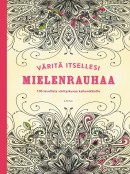 Number three was a book called ‘Find mindfulness by colouring’ (Väritä itsellesi mielenrauhaa, Atena).
Number three was a book called ‘Find mindfulness by colouring’ (Väritä itsellesi mielenrauhaa, Atena).
Colouring books like this one have now become enormously popular; Johanna Basford’s books, for example, have sold millions of copies in various countries.
Has the oh-so-trendy ‘mindfulness’ has now become so frantically pursued that colouring patterns represent a kind of instant, fast-food-type mandala substitute?
Number six on the best-seller list was The 1000 Dot-to-Dot Book by Thomas Pavitte. Haven’t we all done these as little kids: after connecting, tongue in cheek, the dots with a erroneous pencil, a picture of a doggy or a flower, miraculously, appeared on the page? Yes: for adults it’s doggies, too, but also Elvis Presley, Muhammad Ali, Madonna or John F. Kennedy, or the Eiffel Tower (coming up soon, masterpieces of the world art).
Also available is a Kama Sutra dot-to-dot book (first published by Random House: ‘…this wickedly witty book only exposes its 30 exotic positions to the most persistent hands. Put a little lead in your pencil and get stuck in’).
‘It lets me feel like a “real” artist even though it is a simple dot to dot’, said one customer on Amazon’s pages, where the books are sold with the following sales patter: ‘…much more sophisticated than the one-dimensional images created in childhood connect-the-dot activity books…. Dot-to-dot puzzles have also been proven to increase short-term cognitive acuity, hand-eye coordination, and concentration skills.’
Readers say they feel that they ‘realise their creativity’. Uh-huh? (A scary prospect: some say they might even give their finished pictures to friends as gifts.) It isn’t creative though – rather, contemplative. Or was that navel-gazing…
These trends were interpreted in a recent article in the Swedish newspaper Dagbladet as demonstrating the infantilisation of contemporary society. People want to flee from their stressful grown-up duties (life, reality…) – by retreating (or regressing) to their own simple childhood pastimes?
How about, instead of doting on connecting dots to make time pass, people made live contacts with childhood, i.e. real children, or friends, or read a real book? Their brains would benefit more – and so would their mindfulness.
New from the archive
29 June 2015 | This 'n' that
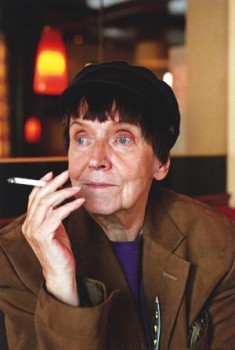
Mirkka Rekola. Photo: Elina Laukkarinen/WSOY
Enigmatic stories, poems and aphorisms by Mirkka Rekola
This week, poems and aphoristic short stories by Mirkka Rekola (1931-2015).
Rekola, as the long-time Books from Finland translator Herbert Lomas put it, was ‘a minimalist before minimalism was invented’. Amazingly enough, her sparklingly terse writing was considered ‘difficult’, and she had to wait until the 1990s before her work was widely read.
Rekola produced her first collection, Vedessä palaa (‘Burning water’) in 1954, making the cardinal mistake of choosing as publisher the conservative WSOY rather than the avant-garde Otava. The book received mixed reviews; as she said, ‘for readers of traditional verse I was completely unfamiliar, while for ultra-modernists I was not modern enough.’
All the work we revisit here shows the extraordinary vividness, accuracy and exuberance of her writing – both in the poems and the often ruefully funny short stories called ‘Mickeys’.
![]()
The Books from Finland digitisation project continues, with a total of 402 articles and book excerpts made available on our website so far. Each week, we bring a newly digitised text to your attention.
Jonna Pulkkinen: Kieltolaki. Kielletyn viinan historia Suomessa. [Prohibition. A history of prohibited liquor in Finland.]
29 June 2015 | Mini reviews, Reviews
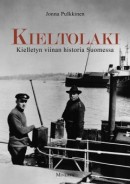 Jonna Pulkkinen
Jonna Pulkkinen
Kieltolaki. Kielletyn viinan historia Suomessa. [Prohibition. A history of prohibited liquor in Finland.]
Helsinki: Minerva, 2015. 213pp., ill.
ISBN 978-952-312-112-6
€32,90, hardback
Prohibition of the making and selling of strong liquor was in force in Finland between 1919 and 1932. In this approachable book, the journalist and non-fiction writer Jonna Pulkkinen charts Finnish attitudes to alcohol over the ages and describes the origin and effects of prohibition. Total abstinence was popular in Finland in the second half of the 19th century, and was adopted in particular by the working class. Limits on alcoholic consumption were first imposed as early as the First World War. When a prohibition law that had been passed a couple of years earlier came into effect in newly independent Finland in 1919, however, support had already begun to dwindle. Home stills proliferated, smuggling from abroad was considerable and broadly accepted, and enforcing the law was difficult. Pulkkinen has numerous interesting and even comical examples that flouted the law on prohibition. The law was broken in all social classes, the use of liquor and crime increased throughout the country, and taxation income on alcohol was lost. As public criticism grew, an advisory referendum was held in 1931, and as a result the prohibition law was abolished the following year.
Living with a genius
23 June 2015 | Extracts, Non-fiction
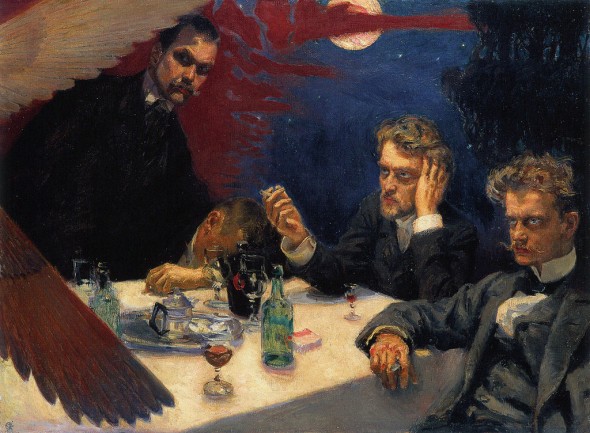
Akseli Gallen-Kallela’s painting Symposium (1894). From left: Akseli Gallen-Kallela, the composer Oskar Merikanto, the conductor Robert Kajanus and Jean Sibelius. Aino Sibelius was not pleased with this depiction of her husband depicted during a drinking session with his buddies
It is 150 years since the birth of Finland’s ‘national’ composer, Jean Sibelius. Much has been written about his life; Jenni Kirves’s new book casts light on his wife, Aino (1871–1969), and through her on the composer’s emotional and family life.
Aino, Kirves remarks in her introduction, has often been viewed as an almost saintly muse who sacrificed her life for her husband. But she was flesh and blood, and the book charts the difficulties of life with her brilliant husband from the very beginning – his unfaithfulness during their engagement, how to deal with a sexually transmitted infection he had contracted, his alcohol problem, the death of a child. It was Aino’s choice, time and again, to stand by her man; she felt it was her privilege to support her husband in his work in every possible way. ‘For me it is as if we two are not alone in our union,’ she wrote, far-sightedly, as a young bride. ‘There is also an equally rightful third: music.’
Aino’s own family, the Järnefelts, were a considerable cultural force in Finland, supporters of Finnish-language education and the growing independence movement. Her brothers included the writer Arvid Järnefelt, the artist Erik Järnefelt and the composer Armas Järnefelt. It was Armas who introduced her to his friend Jean Sibelius.
Aino bore Sibelius – known in family circles as Janne – six daughters, and offered her husband her unfailing support through 65 years of married life. ‘I must have you,’ Sibelius wrote, ‘in order for my innermost being to be complete; without you I am nothing… For this reason you are as much an artist as I am – if not more.’
As an old lady, Aino remarked of her own life that it had been ‘like a long, sunny day.’
![]()
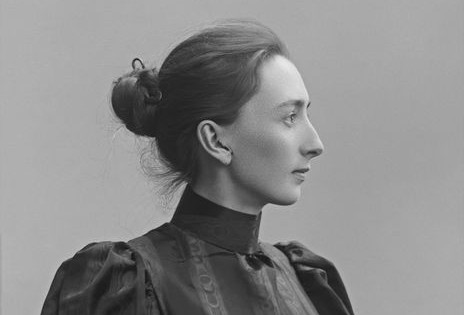
Aino Sibelius, 1891. Photo: National Board of Antiquities – Musketti.
An excerpt from Aino Sibelius: Ihmeellinen olento (‘Aino Sibelius: wondrous creature’, Johnny Kniga, 2015). We join the young couple in 1892 as they prepare for their long-awaited wedding.
At last, the wedding!
In the spring of 1892 the wedding really began to seem possible, as Janne’s symphonic poem Kullervo was very favourably received and Janne finally began to believe that he could support Aino. His financial situation was still, however, far from brilliant, and there were only two weeks to the wedding, as Janne wrote on 27 May 1892: ‘All the same, we must really be very careful about money. You will keep the cashbox and we will decide on everything together.’ The wedding grew closer and three days later Janne wrote triumphantly:
Do you understand, Aino, that we shall be man and wife in 1 ½ weeks – that we shall be able to kiss each other however we like and wherever we like (!) – and live together and have a household together – eat and make coffee together – it’s just so lovely.
A couple of weeks before the wedding, however, Janne wrote to Aino about some wishes for Aino in the future:
A skill with which a married artist can be protected from regressing is that the ‘wife’ understands to make him as little as possible into a model citizen. The man must not be allowed to be a paterfamilias with a pipe in his mouth, drowsy and docile; he must continually seek as many impressions as before, that’s clear, isn’t it? The kind of marriage whose main goal is the bringing of children into the world is repugnant to me – there are most certainly other things to do for those who work in the arts. More…
Risto Uimonen: Juha Sipilä. Keskustajohtajan henkilökuva. [Juha Sipilä. Portrait of a centrist leader.]
23 June 2015 | Mini reviews, Reviews
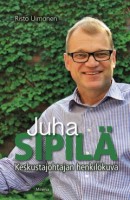 Risto Uimonen
Risto Uimonen
Juha Sipilä. Keskustajohtajan henkilökuva. [Juha Sipilä. Portrait of a centrist leader.]
Helsinki: Minerva, 2015. 431pp., ill.
ISBN 978-952-312-125-6
€33,90, hardback
Juha Sipilä was an information technology millionaire and business entrepreneur when, in 2011, he became, at his first attempt, a member of parliament for the Finnish Centre Party, which represents principally country people, is considered conservative in its values and had lost support. The very next year this engineer from northern Finland was elected chairman of the party. Through, among other things, numerous interviews, the experienced non-fiction writer and journalist Risto Uimonen builds a nuanced portrait of a party leader with a strongly ethical value-system that lies on his Christian faith. Characteristic of Sipilä are informality, consideration of others, practicality and the ability to present issues clearly and pithily. In his party, he has focused on issues that are important to him, such as the promotion of biotechnology. Uimonen offers a fluent portrait of the background to Sipilä’s life and surprising career development, to which, as the book was being completed, a family tragedy brought darker tones. After the publication of the book, Sipilä led the Centre Party to victory in the parliamentary elections of April 2015. As chairman of the biggest party, he began to form a government and has already been praised for his efficiency.
Osmo Soininvaara: Jäähyväiset eduskunnalle [Farewell to Parliament]
23 June 2015 | Mini reviews, Reviews
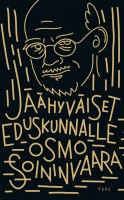 Osmo Soininvaara
Osmo Soininvaara
Jäähyväiset eduskunnalle [Farewell to Parliament]
Helsinki: Teos, 2015. 247pp.
ISBN 978-951-851-649-4
€33, hardback
Long-time member of the Finnish Parliament Osmo Soininvaara, who has also worked as a minister, decided not to participate in the 2015 parliamentary elections. In this timely book, this expert in social politics and influential figure in the Green Alliance examines the reasons for political alienation, analyses politics more broadly and presents his own medicines for improving the situation. According to Soininvaara, the Finnish parliament has become superficial and publicity-seeking and there is much room for improvement in its work. The six-party ‘rainbow coalition’ of the outgoing parliament was incapable of action and the two largest, leftist, parties were continually at loggerheads, with the Social Democrats, in particular, demanding reforms. The divided opposition was toothless. Finland’s economy weakened still further, and it proved impossible to implement the administration’s central projects, reform of the social and health systems and of municipal administration, let alone others, among them the structural administrative changes essential for economic recovery. Writing fluently, Soininvaara examines politics and Parliament from many different perspectives, arguing eloquently for his views.
Lovely black eyes
23 June 2015 | This 'n' that
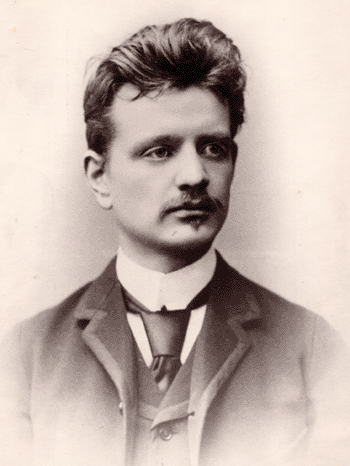
Agony uncle?: Jean Sibelius during his travels in Germany, in 1889
Jean Sibelius on how to keep your mojo
The main music critic of Päivälehti (‘The daily newspaper’) in the 1890s was the celebrated composer Oskar Merikanto, writes Vesa Sirén in Päivälehti’s successor, Helsingin Sanomat. Often, but not always, Merikanto praised first performances of works by the yet more stellar Jean Sibelius.
June 1895, however, saw the publication of Merikanto’s I sommarkväll (‘Waltz for a summer’s night’). ‘Tomorrow’s Päivälehti should have a review by Sibelius!’ wrote an excited Merikanto.
The short review duly appeared the following day, attributed not directly to Sibelius but to ‘a certain prominent composer’. In it, Sibelius hints that its uses may be more than strictly musical:
This waltz is extraordinarily pleasant and clever in both form and content. The introduction immediately reveals the composer’s intentions. This waltz contains an extraordinary passion. It is like our sky, which seems so grey, but which reflects that grey light that is born in black eyes when one is with one’s beloved. Everyone should buy it, for it is the shortest route to acceptance by one’s beloved and to one’s true desires.
New from the archive
23 June 2015 | This 'n' that
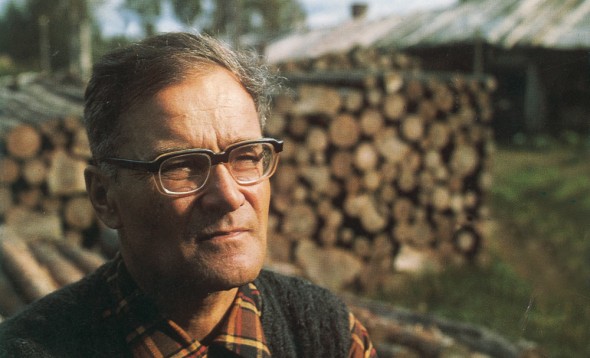
Kalle Päätalo. Photo: Gummerus.
This week, Kalle Päätalo – once Finland’s most successful author
Author Kalle Päätalo (1919-2000) was a rare bird in the book-publishing world. Beginning in 1962, his series of autobiographical novels Juuret Iijoen törmässä (‘Roots on the banks of the Iijoki river’) were published annually in editions of 100,000 copies. At a cautious estimate, one million Finns out of a total population of five million read Päätalo. He was a unique phenomenon, and, for his publishers, a highly lucrative one.
Despite his popularity, this former forestry worker and builder never achieved critical acclaim; the literary establishment remained cool towards him. What was the secret of his enormous appeal? By 1987, when we published this week’s extracts, the way of life Päätalo was chronicling was fast disappearing; he portrayed of the living and working conditions of the far north and the rich dialect of the region with a near-anthropological accuracy. Päätalo’s autobiography was almost coterminous in scope with the existence of independent Finland, and his depiction of the ruggedly individual characters of the north was at the same time a celebration of national values.
In this excerpt, from Tammerkosken sillalla (‘On Tammerkoski bridge’, 1982), the narrator’s excitement as he finds Martin Eden by Jack London – along with the Finnish author Mika Waltari, one of Päätalo’s great writer-heroes – in the local library is palpable. And many of his readers would have remembered the difficulties of living in small apartments at close quarters with other family members, in this case a less-than-congenial mother-in-law: ‘My cock cowered among my pubic hair like a guilty prankster after a practical joke…’.
![]()
The Books from Finland digitisation project continues, with a total of 400 articles and book excerpts made available on our website so far. Each week, we bring a newly digitised text to your attention.
Kai Häggman: Pieni kansa, pitkä muisti. Suomalaisen Kirjallisuuden Seura talvisodasta 2000-luvulle. [Small nation, long memory. The Finnish Literature Society from the Winter War to the 21st century.]
16 June 2015 | Mini reviews, Reviews
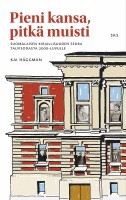 Kai Häggman
Kai Häggman
Pieni kansa, pitkä muisti. Suomalaisen Kirjallisuuden Seura talvisodasta 2000-luvulle. [Small nation, long memory. The Finnish Literature Society from the Winter War to the 21st century.]
Helsinki: SKS, 2015. 524pp., ill.
€48, hardback
The Finnish Literature Society, publisher of Books from Finland, is of unique importance as a collector of Finnish folk poetry and folk tradition, a publisher of literature and a promoter of research into the Finnish language and history; today it is known particularly as one of the most important publishers of the humanities. The historian Kai Häggman has published many works about publishing, and his new book, the third volume of a history of the Finnish Literature Society, describes events from the Second World War to the present day. Among other things, the book describes the Finnish Literature Society’s activities in conquered Eastern Karelia in what was then considered part of the Greater Finland, and its ideological development from narrow nationalism to the broader outlook of the post-war decades. In the late 20th century the generation that had lived through the war was replaced by younger people, and the study of the folk tradition embraced aspects of modern society; methods, too, were renewed. The book also casts light on relationships between Finnish scholars and those from kindred nations such as Estonia. Häggman gives a lively all-round view of the work of the Society as part of Finnish cultural history as a whole, emphasising the importance of the most important scholars, and not forgetting the occasional infighting.
Dracula fights for Finland
16 June 2015 | This 'n' that
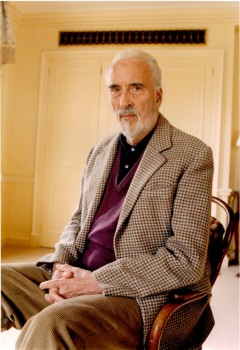
Christopher Lee. Photo: Devlin crow / CC BY-SA 3.0
Actor Christopher Lee loved Finland and knew the Kalevala
Among the obituaries of Christopher Lee, the celebrated actor who died last week at the age of 93, one fact has remained strangely overlooked: his connection with Finland.
Lee (born 1922) specialised in monsters and villains; his most famous roles included Dracula, the Mummy, Frankenstein’s monster, Count Dooku in Star Wars and the wizard Saruman in The Lord of the Rings.
Writing in the Helsingin Sanomat newspaper, Veli-Pekka Lehtonen reveals that Lee knew Finland well. As a very young man he had volunteered for service in the Winter War of 1939; the British soldiers’ skiing skills, however, made them less than useful and they were sent home.
Lee also had an extensive knowledge of the architecture of Helsinki, and loved the Finnish national epic, the Kalevala.
That love came full circle in his role in The Lord of the Rings. J.R.R. Tolkien, the trilogy’s author, was also a Kalevala fan – the inspiration for his work on the kingdom of Middle Earth lay in the Kalevala’s story of Kullervo. As he wrote to his friend, the poet W.H. Auden, in 1955, ‘the beginning of the legendarium… was an attempt to reorganise some of the Kalevala, especially the tale of Kullervo the hapless, into a form of my own.’
Tolkien, a professional philologist, particularly loved the Finnish language. He described finding a Finnish grammar book as being like ‘entering a completely new wine-cellar filled with bottles for an amazing wine of a kind a flavour never tasted before.’
Christopher Lee may not have known Finnish, but he had clearly sampled the same wine.
Antero Holmila & Simo Mikkonen: Suomi sodan jälkeen. Pelon, katkeruuden ja toivon vuodet 1944-1949. [Finland after the war, 1944-1949. Years of fear, bitterness and hope.]
16 June 2015 | Mini reviews, Reviews
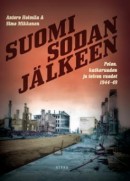 Antero Holmila – Simo Mikkonen
Antero Holmila – Simo Mikkonen
Suomi sodan jälkeen. Pelon, katkeruuden ja toivon vuodet 1944-1949. [Finland after the war, 1944-1949. Years of fear, bitterness and hope.]
Helsinki: Atena, 2015. 2650., ill.
ISBN 978-952-300-112-1
€34, hardback
Finland lost the Winter War and the Continuation War that followed, to the Soviet Union, and was then forced to engage in the short Lapland War to expel its former allies, the Germans. The return to peace was not easy, as the historians Antero Holmila and Simo Mikkonen demonstrate in this highly readable book. Loss of territory meant finding homes for more than 400,000 evacuees elsewhere in Finland, and this was not achieved without difficulty. Soldiers were demobilised and had to redomicile themselves in ordinary life and work; there was a shortage of housing; and heavy war reparations were to be paid to the Soviet Union. Leading politicians accused of appeasing the Soviet Union during the war received prison sentences, which many people considered wrong. The work highlights the aspirations of the Communists and the internal fighting on the political left. The Communist party, which had been banned, returned to the political stage and was successful in the 1945 elections. The majority of the nation was fearful of the growth of influence of the Communists and, through them, the Soviet Union. However, the Social Democrats, competing with the Communists for workers’ votes, succeeded in gaining considerably more votes than the Communists as early as 1948. Although strikes and conflicts occurred, conditions settled down gradually towards the end of the 1940s and the nation began to get back on its feet.
Angels and devils
11 June 2015 | This 'n' that
A new website explores the work of artist Hugo Simberg
Two small boys carry a wounded angel; a farmer’s wife gives milk to a little devil and her twins; skeletons tend the plants in the Garden of Death. The mythical figures that populate the paintings of the symbolist artist Hugo Simberg (1873-1917) have a wayward and macabre charm that is all their own.
The Helsinki Ateneum Art Museum’s new website, The Other World of Hugo Simberg, offers an opportunity to explore Simberg’s life and work. Showcasing twelve of his best-known paintings, it lays a trail through associated visual and textual material – different versions of the works, photographs, sketches, letters….
If you’ve ever wondered what Simberg’s characters might be thinking or saying, the website also gives you the opportunity to provide thought or speech bubbles, which can then be uploaded to the website.
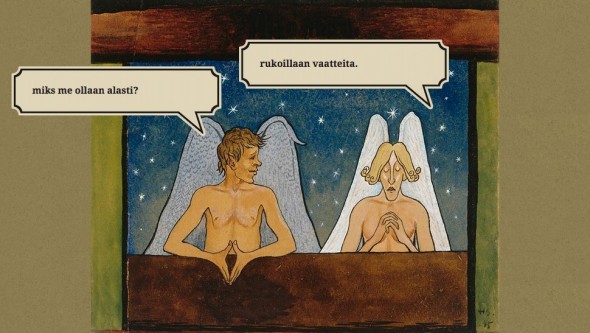
Angelic meetings: ‘Why are we naked?’ ‘Let’s pray for clothes!’ (above); ‘Do you come here often?’ (below).
